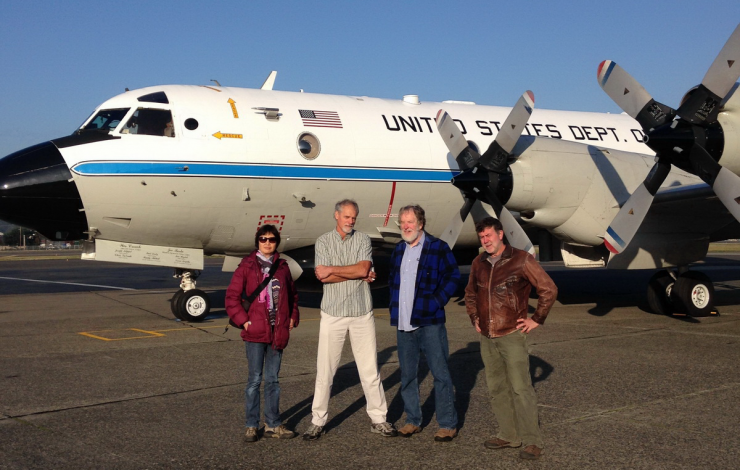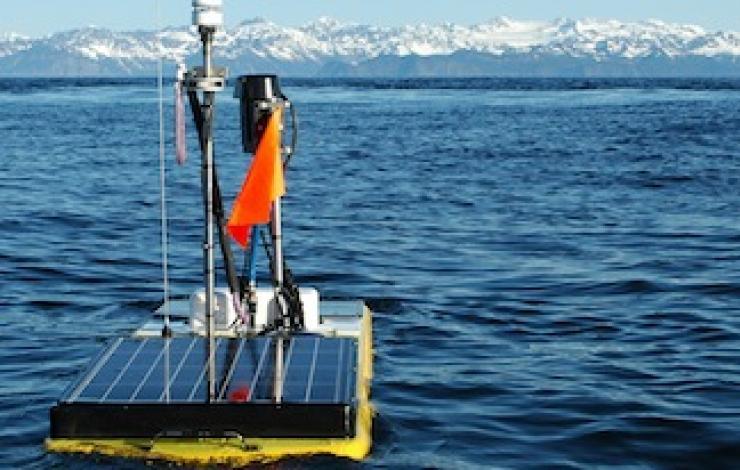What's New Archive
The NOAA-led Arctic Report Card 2014 was released today. In 2014, rising air and sea temperatures continued to trigger changes in the Arctic.
The Arctic is warming at twice the rate of anywhere else on Earth. However, natural variation remains, such as the slight increase in March 2014 sea ice thickness and only a slight decrease in total mass of the Greenland ice sheet in summer 2014.
The warming Arctic atmosphere was strongly connected to lower latitudes in early 2014, with cold air outbreaks into the eastern USA and warm air intrusions into Alaska and northern Europe. Arctic warming conditions are impacting polar bear conditions, northern hemisphere snow cover, sea surface temperatures and primary productivity, tundra and the Greenland ice sheet.
The annual Arctic Report Card tracks recent environmental changes, with 10 essays in 2014 prepared by an international team of 63 scientists from 13 different countries and an independent peer-review organized by the Arctic Monitoring and Assessment Programme of the Arctic Council. Read more...
Deep Sea Research Part II just published a special issue on research in the Bering Sea. Ten PMEL and Joint Institute for the Study of Atmosphere and Ocean scientists contributed to this issue. The Bering Sea Project: Volume III documents the findings of six years of research and the partnership of two ecosystem programs.
The NSF-funded Bering Ecosystem Study (BEST) and the NPRB-funded Bering Sea Integrated Ecosystem Research Program (BSIERP), with in-kind contributions from NOAA and the US Fish and Wildlife Service, have shed light on ecosystem dynamics and how the region may respond to climate change. In particular, researchers found that when and where the sea ice extends are major factors that determine productivity and impact the entire ecosystem of the Bering Sea. To find out more information about these exciting programs, visit the EcoFOCI and BEST-BSIERP websites.
Scientists from PMEL and JISAO took off on NOAA’s Hurricane Hunter P3 aircraft on October 2 from Seattle, Washington heading to Fairbanks, Alaska to take part in 5 flight missions to measure heat flux coming from the Arctic Ocean. This is the second year in a row scientists have flown above Arctic waters. Data gathered from both years to test the hypothesis that increased summer heat storage in the newly sea-ice free ocean regions in the Arctic lead to surface heat fluxes in autumn that are large enough to have impacts on atmospheric temperature, humidity, wind and cloud distributions.
This project has been jointly funded by the Office of Naval Research (ONR) and NOAA, and includes both aircraft and ship operations. To learn more about NOAA's research in the Arctic, visit http://www.arctic.noaa.gov/.
On September 15th, NOAA researchers at Pacific Marine Environmental Laboratory (PMEL) worked with their colleagues at the University of Alaska Fairbanks (UAF) to recover three ocean gliders in the Northern Gulf of Alaska where they have been operating for the past four and half months. This mission, which was the longest ocean acidification glider operation ever conducted, was designed to better understand the impacts that glacial runoff and other biogeochemical processes have on ocean acidification in remote access, high-latitude regions.
Two carbon wave gliders, which ride at the surface of the ocean, provided surface measurements of carbon dioxide (CO2) and dissolved oxygen concentrations as well as temperature and salinity data (Plot 1). Over the course of the deployment, the two surface gliders covered more than 6,700 km and made 4,757 measurements of CO2 in the air and seawater.
Simultaneously, a subsurface Slocum glider made over 5,400 dives through the water column down to 200 m, collecting 404,912 measurements of temperature, salinity and dissolved oxygen (Plot 2) while covering a horizontal distance of over 2,700 km along the continental shelf. All of the gliders were controlled remotely and in real-time from Seattle, WA using new interface software that can be run from any laptop or handheld device, allowing the glider pilots more flexibility during operations.
During the deployment, preliminary data from all three gliders was transmitted back to PMEL where it was analyzed and used for dynamic mission planning. This allowed the two lead scientists, Dr. Jeremy Mathis at PMEL and Dr. Wiley Evans at UAF to modify the tracks of each glider to best capture changing ocean parameters throughout the spring and summer. In the coming months scientists will process and try to understand all of the data, but this mission has proven that autonomous gliders are and will be a critical component of NOAA’s mission to gather environmental intelligence in the future.
A new study led by PMEL's Dr. Jeremy Mathis, published online July 29 in Progress in Oceanography, shows that many of Alaska's economically valuable marine fisheries are located in waters already experiencing ocean acidification. The economy and livelihood of communities in southeast and southwest Alaska are expected to be particularly vulnerable to ocean acidification and have underlying factors making these communities more susceptible. Studies show that red king crab and tanner crab, two important Alaskan fisheries, grow more slowly and don’t survive as well in more acidic waters. Alaska’s coastal waters are particularly vulnerable to ocean acidification because of cold water that can absorb more carbon dioxide, and unique ocean circulation patterns which bring naturally acidic deep ocean waters to the surface.
Read more on the NOAA press release and visit PMEL's ocean acidification research page.
Led by Dr. Jeremy Mathis, PMEL teamed up with the University of Alaska and the Alaska Ocean Observing System this summer and early fall to use new unmanned tools to study how melting glaciers in Alaska’s Prince William Sound may be intensifying ocean acidification in the sound and on the Gulf of Alaska continental shelf. PMEL engineers outfitted two Carbon Wave Gliders and one underwater Slocum glider with sensors to help better understand the unique processes of glacial melt water and how they change the chemistry of the water column in Prince William Sound.
To read more about this project please visit the NOAA Research News website.
PMEL is coordinating the NOAA effort on the Russian-American Long-Term Census of the Arctic (RUSALCA) cruise. The 40 day cruise left on September 1 and is being conducted to observe physical and biological environmental changes in the Northern Bering and Chukchi Seas.
For more information please visit the RUSALCA web site on the Arctic theme page.
The NOAA supported Arctic Report Card for 2009 was released on October 22nd. PMEL scientist Dr. James Overland and University of Washington scientist Dr. Muyin Wang contributed to the report that states that warming of the Arctic continues to be widespread, and in some cases, dramatic.
To read more about the atmosphere, sea ice, biology and other topics in the Arctic please visit the 2009 Arctic Report Card web site.
Drs. James Overland and Richard Feely will help represent the United States and NOAA at the upcoming United Nations Climate Change Conference (COP15) in Copenhagen, Denmark that begins on December 7. Dr. Overland will discuss global warming in the Arctic and Dr. Feely will talk about ocean acidification and its impacts on the marine ecosystem.
Please visit PMEL’s Arctic and ocean acidification web pages for more information on these topics and follow the COP15 online.
On March 16, 2010 PMEL launched a new web site to help those interested in the Arctic learn more about the longer-reaching impacts of the loss of Arctic summer sea ice with a new website, https://www.pmel.noaa.gov/arctic-zone/future/. Changes in the Arctic are not only affecting sea ice but models show that they can impact weather in the mid-latitudes as well, where a large part of the population lives.
For more information on the Arctic please visit NOAA's Arctic theme page.







